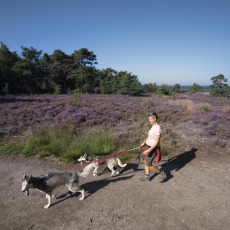It is imperative that we act now. A range of measures is intended to ensure that the diversity of plant and animal species on the Sallandse Heuvelrug is preserved and enhanced.
The national PAS (Programmatische Aanpak Stikstof, Integrated Approach to Nitrogen) was established to preserve the quality of protected nature areas (Natura2000). This involves national efforts and measures to reduce nitrogen emissions. We are also taking local measures to enhance nature. The Dutch Forest Management Agency and the Society for the Preservation of Nature are using the PAS measures to tackle the impact of nitrogen emissions on the Sallandse Heuvelrug. Enhancing nature in an area means it will not deteriorate any further, which creates expansion opportunities for businesses outside of the area.
The trigger
To explain the situation on the Sallandse Heuvelrug, it is important to go back in time a ways. This is because the heathland landscape has changed dramatically over the last century. The heathland, as well as the farmland, used to be virtually without trees. There were hardly any forests. The hedgerows and waterways were intensively managed for coppicing. The flanks of the ridge were wet and marshy, with wet heathland and ponds and wet, flowery meadows. The drier parts were used as arable land, with food crops, cornflowers and poppies. It was an open landscape, with alternating wet and dry areas. Where agriculture and nature where interwoven like a patchwork quilt.
Desiccation
After the steam engine and artificial fertiliser where invented, uncultivated land was put to use in no time. The wet heathland was reclaimed and used for agriculture, the dry heathland was forested for wood production - which meant that flowers disappeared from the meadows and farmland. Drinking water abstraction caused even more drying out. The result: wet areas were turned into dry areas. However, many animal species need exactly this type of landscape: varying conditions and their associated plants.
Fragmentation
What’s more, the heathland is currently surrounded by forest. The heathland is no longer connected to the surrounding landscape, so that there is little or no exchange or dispersion of various species. The curlew chick has difficulty reaching - or is unable to reach - the food-rich farmland in the outer areas.
Acidification
In addition, the emissions from traffic, industry and agriculture pose a severe danger to biodiversity on the Sallandse Heuvelrug. Small ammonia particles, sulphur oxides and nitric oxides spread throughout the environment and acidify the upper soil layer. Some plants on the Sallandse Heuvelrug thrive with these substances and start to dominate; other unique types will succumb, including sedge, erica carnea heather and calluna vulgaris heather. Research shows that the soil on the Sallandse Heuvelrug is currently as acidic as household vinegar. Most plant roots and soil fungi (mushrooms) cannot survive in these conditions and are now virtually extinct on the heathland.
Although heather is fairly resistant to acid, it also suffers from acidification, meaning that many insects have practically disappeared from the heathland. This has an effect on chicks of species like the black grouse, curlews and the northern wheatear, who eat these insects. Food is now almost impossible to find.
National approach to nitrogen
The strain caused by nitrogen poses a problem for virtually all nature areas in the Netherlands. Therefore, the measures taken on the Sallandse Heuvelrug are part of the PAS (Integrated Approach to Nitrogen). The national approach consists of four parts:
- Technological developments that reduce nitrogen emissions.
- Ecological measures aimed at restoring nature and enhancing its resilience.
- Regulation of the permit system to offer entrepreneurs sufficient scope for economic development.
- Monitoring the impact of the measures.
The Dutch Forest Management Agency and the Society for the Preservation of Nature take measures that are part of programme segment 2 in order to enhance nature. With this, the Sallandse Heuvelrug promises to become a healthy and sustainable habitat for the future, incorporating space for nature, recreation, agriculture and economy.










